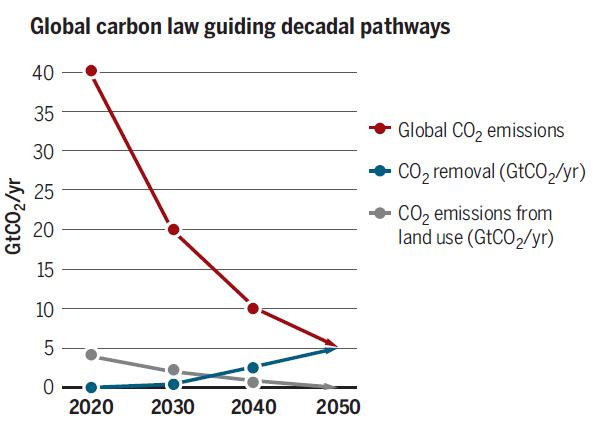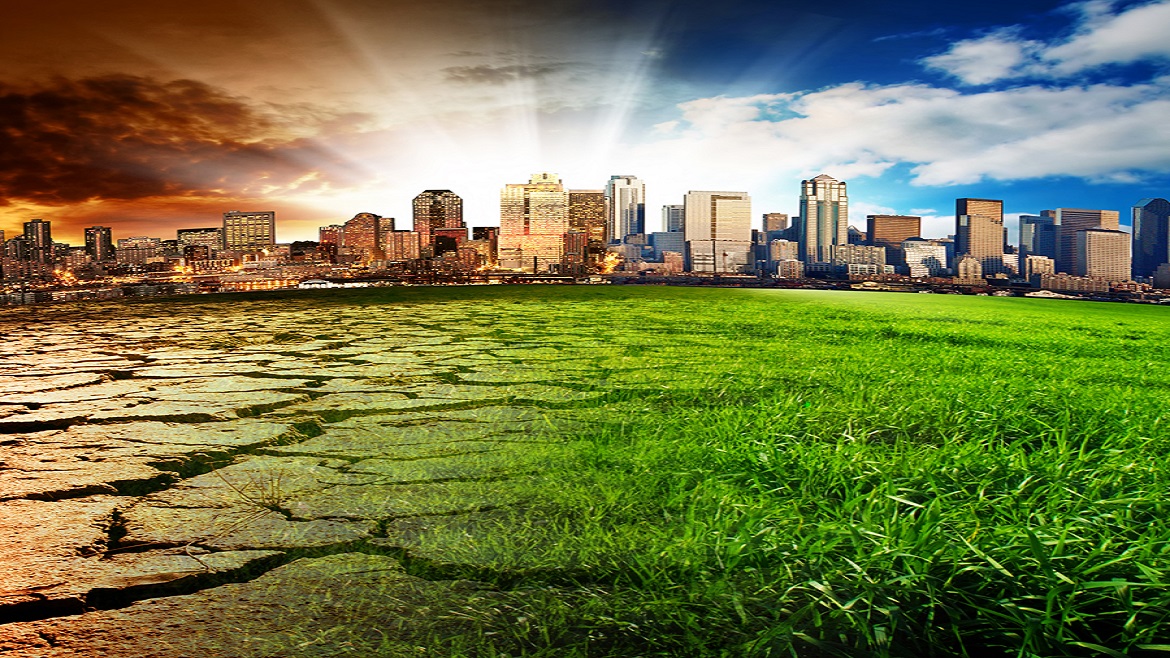Greenhouse-gas emissions from human sources need to fall from 51.9 gigatonnes of carbon dioxide equivalent emitted in 2016 to net zero by 2050 to stay within 2 degrees C warming. Net zero means that the world economy of 9.7bn people in 2050 (according to UN population forecasts) could still produce emissions but would also need to be removing a corresponding amount through a change in land use and other solutions.
The Carbon Law
What would it take to hold temperatures to 2 degrees C above pre-industrial levels, the maximum increase agreed in Paris in 2015? According to Rockstrom et al. carbon emissions need to peak by 2020 then halve every decade. This pathway they call a Carbon Law, akin to Moore’s law in technology or to Swanson’s law on the reduction of costs for solar panels. Professor Rockstrom goes on to state that “it’s way more than adding solar or wind. (…) It’s rapid decarbonisation, plus a revolution in food production, plus a sustainability revolution, plus a massive engineering scale-up [for carbon removal].”
Decadal halving corresponds to a 5% per year decrease or more, while renewable capacity in primary energy needs to double every six years or so—the actual current trajectory, as it happens. The roadmap neatly turns a distant goal into a series of short-term targets that can be applied by cities, companies, households and countries at all scales. This means, if a country pulls out of the UN climate agreement, companies and cities could adopt a Carbon Law and stay in. On this pathway, coal would exit the energy mix around the year 2033 and oil about 2042. Halving every decade accumulates around 600 gigatonnes of emissions by end of century (all of which must be removed to aim for a warming of 1.5 degrees Celsius, which is much less dangerous than 2 degrees, according to Owen Gaffney, global sustainability analyst at Stockholm Resilience Centre and Future Earth. This helps to create an essential insurance against nature’s own carbon stores turning from friend to foe and begin emitting carbon at scale (for example methane release from permafrost or rainforest die off).

Source: Rockstrom et al. 2017
Drawdown
Project Drawdown takes a somewhat different and complementary approach by focussing on solutions that can achieve “Drawdown”, which refers to the reversal in rising concentrations of greenhouse gases in the atmosphere. The book, Drawdown, describes 100 technologies and practises that can together reverse global warming. Based on ongoing collaborative research of over 200 individuals who are mapping, measuring, and modelling these solutions, the top 80 “are already in place, well understood, analysed, based on peer-reviewed science, and are expanding around the world,” says Drawdown’s editor Paul Hawken. Twenty solutions are profiled as “coming attractions”, not yet ready for implementation, but when they come online their impact could advance progress towards Drawdown substantially.
For the 80 existing solutions, emissions avoided, net cost and net savings are forecast over 30 years (the coming attractions do not have sufficient data yet to do so). There are three increasingly ambitious scenarios (plausible, Drawdown and optimal). The scenarios focus only on the direct greenhouse-gas (GHG) and financial impacts of the solutions, leaving aside other impacts—such as savings associated with human lives and health, as well as incentives that drive implementation, for example a carbon price—to their next phase of research. The results are, nonetheless, outstanding and, most importantly, fully realisable, with the right incentives.
For the plausible scenario cost savings would be 2.7 times total net costs (costs and/or savings could not be estimated for all 80 solutions) and the total amount of carbon dioxide avoided and sequestered would be a staggering 1,051 gigatonnes.
If you remove the plausible scenario’s conservative bias and factor in a more ambitious growth for all solutions, including 100% renewable energy by 2050 (albeit, regrettably, including biomass, landfill methane, nuclear and waste-to-energy), a net 590m tonnes are removed from the atmosphere by 2050. This is the Drawdown scenario.
100% Renewables and 100% Electrification
Mark Jacobson from Stanford University argues that 100% renewable wind, water and sun (WWS) and 100% electrification of all sectors by 2050 requires 42.5% less energy and produces zero emissions. Zero emissions would prevent 4-7m lives being lost prematurely and stop hundreds of millions from becoming ill due to air pollution. About 24m net jobs would be created and energy would be around US$0.1/kWh, which is cheaper, more stable (because fuel costs are zero) and more easily accessed (due to decentralisation) than business as usual. About US$23trn/year in costs from 2050 air pollution would be saved by 2050 as would about US$28.5trn/year in climate costs, while warming would be limited to 1.5 degrees Celsius. Marc Jacobson et al. have developed roadmaps to transform the "all-purpose energy infrastructures (electricity, transportation, heating/cooling, industry, agriculture/forestry/fishing)" of 139 countries to ones powered by WWS.
Conclusion
Businesses and states have a once-in-a-century opportunity to reduce climate change: by decarbonising their businesses and by defining the so-called Nationally Determined Contributions (NDCs)—the post-2020 national climate targets, including mitigation and adaptation, following the 2015 Paris Agreement—with the levels of ambition of the Carbon Law, Drawdown and 100% renewables and electrification. Both businesses and states as partners, together with all stakeholders (investors, cities, regions, consumers etc.) must now invest in and deploy the 100 solutions most relevant to them in order to give the world a chance to stay within 2 degrees Celsius of warming. The more aggressively emissions are avoided over the next three decades the less they will have to be removed from the atmosphere (for example through geoengineering).
Acknowledgements: The author wishes to acknowledge Owen Gaffney, global sustainability analyst at Stockholm Resilience Centre and Future Earth; Chad Frischmann, vice-president and research director at Project Drawdown; and Mark Jacobson, professor of civil and environmental engineering and director of the Atmosphere/Energy Program at Stanford University for their revision and contributions to this blog.
The views and opinions expressed in this article are those of the authors and do not necessarily reflect the views of The Economist Intelligence Unit Limited (EIU) or any other member of The Economist Group. The Economist Group (including the EIU) cannot accept any responsibility or liability for reliance by any person on this article or any of the information, opinions or conclusions set out in the article.




